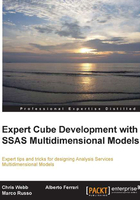
Choosing an edition of Analysis Services
Before we start developing with Analysis Services, we need a clear idea of which edition of Analysis Services we're going to be developing for. There are three choices: Standard Edition, which is the cheapest but is missing some features; and BI Edition and Enterprise Edition, which are more expensive, but feature-complete. The only difference between BI Edition and Enterprise Edition, as far as Analysis Services Multidimensional goes, is that BI Edition is licensed on a server and Client Access License (CAL) model, whereas Enterprise Edition is licensed on a per-core model. The licensing cost is likely to be the major factor in the decision about which edition to choose. If money is no object, then you should use Enterprise Edition or BI Edition.
If money is an issue, then you'll just have to live with the limitations of Standard Edition. Of course, if we install Analysis Services on a server that already has SQL Server installed, then there are no extra license costs involved, but as we'll see in Chapter 11, Monitoring Cube Performance and Usage, we have to be careful they don't compete for resources. The SQL Server 2012 Licensing Guide gives a detailed breakdown of which features are available in each edition, and can be downloaded from http://tinyurl.com/sql2012licensing.
Don't worry about having to use the Standard Edition though. Some of the features it lacks can be recreated with a little bit of extra work. The key features in Enterprise Edition and BI Edition are in the area of performance for very large or complex cubes, and you can go a long way with Standard Edition before you really need to use these features. The Deployment Server Edition project property, which is described next, will help you make sure you only use the features available in the edition of your choice.